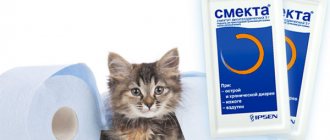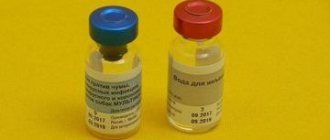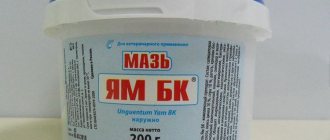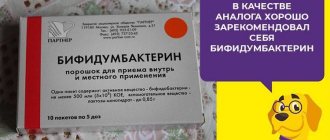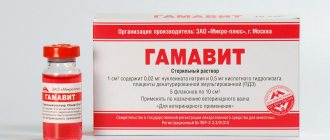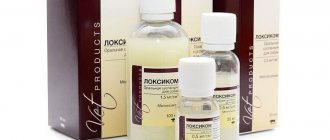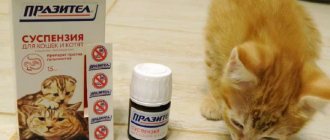What is Prednisolone
Prednisolone is a synthetic glucocorticosteroid drug that helps eliminate the inflammatory process. Available in five varieties. The active ingredient for all dosage forms is prednisolone. The medicine has the following properties:
- reduces the intensity of pain;
- relieves swelling;
- eliminates acute allergic reactions;
- reduces symptoms of itching;
- reduces the number of rashes due to dermatitis;
- accelerates tissue healing;
- constricts blood vessels.
This medicine helps to cope with the shock that occurs with severe burns, injuries and anaphylactic reactions. In the treatment of cats, the drug is also used as an auxiliary method for the treatment of adrenal diseases. Sometimes Prednisolone even helps to save a pet’s life, for example, with progressive swelling of the larynx.
Prednisolone is a glucocorticosteroid medication
Composition of the drug
One tablet contains the active substance 1 or 5 mg, colloidal silicon dioxide, stearic acid, magnesium stearate, potato and corn starch, lactose monohydrate and talc.
Prednisolone ampoules contain 30 mg per 1 ml of active substance, sodium pyrosulphide, disodium edetate, sodium hydroxide, nicotinamide, water for injection.
Prednisolone ointment contains 0.05 g of active substance, glycerin, white soft paraffin, stearic acid, propyl and methyl parahydroxybenzoate and purified water.
When is medication prescribed - table
| Release form | Indications |
| Pills |
|
| Solution |
|
| Ointment |
|
| Eye drops |
|
| Lyophilisate |
|
The principle of influence on the body
The administration of Prednisolone intramuscularly allows for optimal anti-shock, anti-inflammatory, immunosuppressive and analgesic effects. Once in the patient’s body, the drug forms a specific glucocorticoid receptor. The active substance quickly penetrates into the cell nucleus, where interaction with genes occurs. Because of this, a serious change is formed in the production of RNA and proteins. In medicine, Prednisolone is highly valued for its excellent anti-inflammatory effect, which is achieved due to the following factors:
- The main substance prevents the exchange of genes from the COX-2 category. Due to this, the production of prostaglandins is reduced.
- The active components several times increase the natural production of lipocortin, which prevents the formation of phospholipase. Because of this, damaged tissues cannot produce arachidonic acid.
- The drug stops metabolic processes between molecules in blood vessels, so that monocytes and neutrophils do not penetrate into the inflammatory focus.
Operating principle
Prednisolone is able to suppress the activity of leukocytes, thereby reducing the intensity of the body's inflammatory response. This reduces the permeability of the vascular walls and the synthesis of prostaglandins - mediators that are responsible for the occurrence of pain. In addition, this glucocorticosteroid affects the production of histamine, the main provocateur of an allergic reaction.
Prednisolone is often used for allergies in cats of unknown cause.
The active component also increases blood glucose levels and is quickly absorbed by any method of application. In addition, this drug replenishes the deficiency of adrenal hormones. However, the drug not only has a positive effect, but can also provoke excessive production of hydrochloric acid, which contributes to the appearance of stomach ulcers.
Attention! Prednisolone can disrupt your pet's metabolism when used over a long period of time, promoting fat accumulation. In this case, the cat recovers quickly, but its appetite may remain unchanged.
Indications
Prednisolone can serve as the basis of therapy for chronic and acute diseases. The drug is injected into the muscle when an allergic reaction suddenly develops. The medicine quickly enters the bloodstream and the serious condition subsides. They treat oncology, diseases of the eyes, gastrointestinal tract and joints. Often used in the treatment of lupus erythematosus and mononucleosis. With its help they fight with:
- anemia;
- colitis;
- atopic dermatitis;
- eczema;
- mastocytoma;
- neurodermatitis.
A wide spectrum of action allows Prednisolone to be prescribed as part of the treatment of Addison's disease, myasthenia gravis, and blood diseases.
Therapy for skin problems lasts from two to three months to several years. In the case of treatment of bronchial asthma and some chronic diseases, the veterinarian may prescribe the drug for life.
Contraindications
A contraindication to the use of the product is the period of bearing offspring and feeding kittens. Prednisolone is not always beneficial for a cat, especially if the drug is used for other purposes. Veterinary medicine has several cases in which the medicine only harmed the animal because the specialist’s recommendations for use were not followed. Urgent discontinuation of the drug is required if the pet has a severe allergic reaction. It is not recommended to be treated with Prednisolone for chronic renal failure (chronic renal failure), as well as in the following cases:
Prednisolone for cats: indications and contraindications
The decision to use the corticosteroid hormone Prednisolone or its analog Prednisone is made by a veterinarian for the treatment of the following diseases and pathological conditions:
- diseases of the musculoskeletal system;
- anemia;
- allergic reactions, bronchial asthma;
- cancers of the circulatory system;
- nephritis, renal coma;
- adrenal gland diseases;
- conjunctivitis;
- blepharitis;
- eczema, dermatitis.
Prednisolone is contraindicated in the following situations:
- renal failure;
- diabetes;
- ulcerative lesions of the intestines and stomach;
- pregnancy and lactation;
- during the period of antibody production after vaccination;
- during the treatment of infectious diseases.
Features of application
The treatment regimen depends on the specific pathology, since the drug can be used for long-term therapy, as well as as an emergency treatment. The veterinarian determines which release form to use after a series of studies and diagnosis.
Tablets: treatment regimen and dose
The dose is calculated based on the pet's weight. For 1 kg, 0.3–0.5 mg of the drug is provided. Tablets can be given mixed with food or forcibly 2 times a day for 14 days. The exact course is determined by the doctor depending on the nature of the pathology. In order for the pet not to notice the presence of the medicine in the food, the tablets must be thoroughly crushed. If this method is not suitable, then the drug can be placed on the root of the cat’s tongue or infused using a disposable syringe after preliminary crushing and mixing with water.
The easiest way is to give the tablet to your cat by first crushing it and mixing it into the food.
Attention! Before giving your pet a tablet, you should carefully secure it to avoid bites and scratches. To provoke the swallowing reflex, it is recommended to stroke the cat's neck immediately after manipulation.
How to give a cat a pill - video
How to use the solution and lyophilisate
The lyophilisate is used in the same way and in the same dose as the solution. The amount of the drug is calculated based on body weight. For 1 kg approximately 0.5 ml of medicine. The solution and lyophilisate are used for no more than 5 days. Prednisolone is administered to pets only intravenously in a veterinary clinic once a day. In this case, it is prohibited to give an injection yourself, since if the actions are performed incorrectly, undesirable reactions may occur.
Only a specialist should give an intravenous injection to a cat.
Most often, the solution and lyophilisate are used in emergency cases, for example, when a pet has been seriously injured. Intravenous administration of the medicine can alleviate the cat’s condition in just a matter of minutes.
Dosage and duration of treatment with ointment
The ointment is used mainly for allergic or atopic dermatitis. It is applied to the affected areas once a day for a period determined by the doctor. Often the course of treatment does not exceed 1 week. After applying the product, it is important to put a blanket or protective collar on the cat, thereby preventing the ointment from being licked off.
The blanket helps prevent licking of the ointment
Attention! If the cat has thick hair, then it must first be cut off in the area where you plan to apply the ointment. Otherwise, the product may not be absorbed well.
Our cat had an allergy of unknown cause. The veterinarian recommended trying to change the food, and also prescribed Prednisolone ointment, because the pet was constantly scratching and licking its belly. As a result, there was practically no wool left in this area. Prednisolone had to be used for a long time, the stomach gradually grew larger, but it was noticeable that the cat had gained several kilograms. Unfortunately, after stopping the medication, the allergy returned again.
How to use eye drops
Drops are used 1-2 times a day depending on the pathology. The course of treatment varies from 5 days to a week. One drop is provided for each eye. To do everything correctly, it is recommended to wrap your pet in a towel or blanket, and you should also ask someone to hold the cat's head.
The cat needs to instill the medicine 1-2 times a day.
If they get into inflamed eyes, the drops can cause pain, so the pet will actively resist. It is recommended to stroke your pet and talk to it as gently as possible in order to reduce stress.
How to put medicine in a cat's eyes - video
Application: how to inject or give medicine to an animal?
Before giving Prednisolone to cats, you must carefully read the instructions for use and first consult with a doctor. If medicine is required to relieve an inflammatory reaction, then internal administration of the solution is prescribed. It is better for specialists to inject Prednisolone in order to avoid harm to the pet. The daily dose is 0.3-0.5 mg per kilogram of cat weight. When immunosuppression is diagnosed, the dosage per day is increased to 1-1.5 mg/1 kg of the pet’s body weight. The duration of therapy should be no more than 14 days. The easiest ointment to use, which needs to be applied to the cat's fur in a thin layer 1-2 times a day.
Release form
Prednisolone is available in the form:
- Tablets in dosages of 1 and 5 mg,
- Solution for injection with a volume of 15 mg/ml 2 ml and 30 mg/ml 1 ml,
- Ointments with a dosage of 0.5%,
- Eye drops dosage is also 0.5%.
It belongs to a type of corticosteroid and sometimes, along with the name Prednisolone, you can also find Prednisone. The drug is freely available in pharmacies.
The main purpose of corticosteroids is to replace the natural hormone cortisol, which is produced by the adrenal cortex. There is an effect of corticosteroids on the immune system, as a result of which the production of substances that cause autoimmune and inflammatory reactions is blocked.
Prednisolone for cats: instructions for use for different forms
The drug is used for cats in the following therapeutic forms:
- Injection. Available in ampoules of 1 or 2 ml. The content of the active substance in one vessel is 30 mg. The course of treatment should not exceed 7 days. The dosage is determined by the veterinarian depending on the condition of the pet’s body and the severity of the disease.
- Pills . Prescribed when there is no need to give injections. For cats, it is convenient to use 1 mg pills; they constitute a single dose for an animal weighing 3.0-3.5 kg. Unless otherwise prescribed by your veterinarian, the tablets are taken twice daily for two weeks.
- Ointment . Used as part of complex treatment of skin diseases characterized by severe inflammation. Before using the drug, the pathological surface is cleaned of crusts and exudate, and the hair is cut off. The ointment is applied in a thin layer, covering up to 1 cm of clinically healthy skin surface. Depending on the severity of the inflammatory process, the procedure is carried out 1 or 2 times a day. The duration of treatment is no more than 7 days.
- Drops . Used as part of complex therapy for diseases whose symptoms are inflammatory eye diseases. The standard treatment regimen involves applying 1 drop 3 times a day to each eye, even if only one hurts. The course of treatment is until recovery, but not more than 10 days. Before instillation, the pathological surface is freed from crusts and secretions.
Can it be used to treat pregnant cats and kittens?
Glucocorticosteroid drugs cannot be used to treat pregnant and lactating cats, as such medications can cause dangerous consequences, including fetal death. Also, Prednisolone is not used to treat kittens. The drug can be used only from the first year of life.
The drug is not used to treat kittens.
Attention! Glucocorticosteroids penetrate the placental barrier and are also absorbed into breast milk, contributing to metabolic disorders in kittens.
Precautionary measures
Mistakes when administering Prednisolone to cats can seriously affect their health. Therefore, when working with the drug, it is important to remember the following rules:
- Before using Prednisolone, you should wash your hands thoroughly with soap;
- During the manipulations, it is prohibited to consume drinks or food, or be distracted by smoking.
- If the owner of an animal has increased sensitivity to a hormonal drug, it is necessary to avoid contact of the drug with the skin or mucous membranes (mouth, eyes).
If this happens, you should rinse the contact area with plenty of water. In a situation where the drug accidentally entered the human body, you should immediately seek medical help.
© shutterstock
It is important to determine a convenient place where manipulations with the animal will be most convenient. Treatment should not be used in the kitchen, whether by injection or oral administration of the drug. It is advisable to choose a flat, horizontal surface, especially for administering injections. It is advisable to administer prednisolone in this form slowly, without sudden movements. An assistant may be needed to hold and calm the cat while a second person administers the injection.
It is important that during treatment the owner monitors the correct daily routine of the cat. Also, during course therapy, you should regularly take hormone tests. Negligent attitude to strict adherence to dosages can cause irreparable harm to the health of the animal.
Do not use Prednisolone if the expiration date has expired (3 years from the date of manufacture). The drug should be stored at a temperature of 15-20 C in a place where it will not be found by children or pets.
Side effects and warnings
The following undesirable symptoms may occur during treatment with this medication:
- weight gain;
- heart rhythm disturbances;
- increased blood pressure;
- convulsions;
- headache;
- loss of coordination;
- damage to bone tissue;
- frequent urge to urinate;
- stomach ache.
In what cases is the drug not recommended for use:
- for heart diseases and inflammatory processes occurring in the gastrointestinal tract;
- when there are parasites in the pet’s body;
- if the cat suffers from endocrine disorders.
Short-term use of Prednisolone often does not cause serious side effects.
Reviews
You can find a lot of positive reviews from animal owners about Prednisolone. This drug effectively relieves severe allergic reactions in cats after insect bites. It quickly relieves joint pain in older animals with rheumatism and arthritis. Cat owners note that corticosteroid injections for uremic coma and adrenal insufficiency helped save the pet’s life.
You can also find negative reviews about this medicine. During treatment, some animals experienced a sharp increase in weight and worsened coat condition. At the same time, apathy and increased thirst were noted.
Corticosteroids can indeed disrupt the hormonal balance in the body, especially when taken for a long time. This can affect fat metabolism and lead to weight gain, as well as increased work of the sebaceous glands. Therefore, during the course of treatment, it is necessary to ensure that the cat does not overeat. It is also necessary to limit the amount of fats and carbohydrates in the animal’s diet. Usually, after completing the course of treatment, the weight returns to normal, and the condition of the coat is quickly restored.
Purpose
Most often, Prednisolone is used as an effective antiallergic agent, but its scope of action is much wider, so the hormonal drug is used for therapy:
- acute viral diseases;
- skin lesions;
- pathologies of the immune system;
- chronic adrenal insufficiency (in which cortisone is not produced by the animal’s body or is produced in insufficient quantities);
- bilateral recurrent inflammation of the eyelids and inflammation of the eye mucosa;
- malignant neoplasms and other pathologies.
Medicines with similar effects - table
| Name | Release form | Active ingredient | Indications | Contraindications | Adverse reactions | Can it be used for therapy in pregnant cats? | Price |
| Hydrocortisone |
| hydrocortisone | Acute allergic reactions and inflammatory processes, including autoimmune ones. |
|
| No. | From 132 rub. |
| Dexamethasone |
| dexamethasone | Allergic reactions, inflammatory diseases of connective tissue and skin, as well as various types of dermatitis. |
|
| No. | From 60 rub. |
| Dexafort | Suspension | dexamethasone | Inflammatory pathologies and autoimmune diseases of various etiologies. |
|
| No. | From 1000 rub. |
Drugs similar in principle of action - photo gallery
Dexafort is intended specifically for the treatment of animals
Dexamethasone can cause high blood pressure
Hydrocortisone is one of the powerful glucocorticosteroids.
Prednisolone is a complex action drug that allows you to quickly get rid of a number of severe symptoms. The medication, in addition to its positive effect on the body, has a lot of contraindications and side effects. If you use such a remedy in the correct dosage, you can achieve a quick positive result from therapy.
Side effects
Prednisolone has a very large number of secondary effects, due to the fact that it contains a huge range of effects on the body.
The dog owner may be giving the drug incorrectly. For example, he sharply reduces the dose of a substance, or forgets to give it one day, and on the second he gives a double dose. This should not be done, as this can only worsen the dog’s condition. The animal may experience the following health problems:
- Problems with the endocrine glands;
- Functions of paired endocrine glands;
- Incorrect potassium ion ratio;
- The dog's bones become weak;
- Blood sugar levels may be disrupted;
- Immunity will decrease.
To prevent similar changes from occurring, follow all veterinarian recommendations. This includes taking tests, proper care, and treatment with a prescribed drug. You may need a blood test or x-ray. In this case, no secondary results will arise.
What to do when you forgot to give a dose of medicine
Naturally, it is better not to skip taking the drug. The dog owner is required to give hormonal substances daily, at the same time. When you miss another dose, give the medicine quickly. When it is time for your next dose, do not take the missed dose but continue therapy. There is no need to give a double dosage.
Injections
It is most effective to use injections as an emergency aid. Intramuscular injections are administered more quickly than other forms of medication. Since this form of release enters the bloodstream much faster. Thus, a veterinarian may recommend injections for changes in cartilage tissue, asthma or skin diseases at the acute stage. The course of therapy does not exceed seven days. The animal is given injections up to two times throughout the day. At the end of the course, the main thing is to reduce the dose of the substance little by little, since stopping the drug too suddenly can cause complications of the disease.
Content
1. General description 2. Characteristics 3. Purpose 4. Application 5. Contraindications 6. Side effects 7. Forms and features of use 8. Price 9. Reviews
Many human drugs are successfully used in veterinary medicine. Veterinarians use the well-proven drug Prednisolone as an anti-inflammatory drug; they prescribe it after operations, in cases of shock, and allergies. Prednisolone can be used for dogs only after consultation with a veterinarian - the drug is hormonal, requires strict adherence to the dosage and is not suitable for self-medication.
general description
The human drug has long been used in veterinary medicine, in particular to treat dogs. The main component in it is prednisolone sodium phosphate. The concentration of the active substance depends on the dosage form. In pharmacies the drug is sold in the following forms:
- pills;
- injection;
- ointment;
- eye drops.
For animals, tablets are usually used, since the concentration of the active substance in them is low, so it is not difficult to calculate the correct dose. To provide emergency assistance, for example, in case of anaphylactic shock, injections are given. When administered intramuscularly, the drug begins to act many times faster, although the concentration in the blood reaches its maximum value only after a few hours.
Prednisolone drops and ointment are used less frequently for dogs. Among veterinary medications, it is not difficult for them to choose a worthy alternative. Regardless of the form of release, hormonal medication should not be used on animals without prior consultation with a veterinarian.
What is the best replacement?
Dexamethasone
Which of these drugs is better - there is no definite answer to this question; it all depends on the patient and his disease. After the examination, the veterinarian will prescribe the most appropriate of these two drugs for a particular case.
Important : Prednisolone and Dexamethasone cannot be used at the same time.
Cyclosporine
Prednisolone can only be replaced with analogues from the glucocorticosteroid group, to which Cyclosporine does not belong.
Other means
Prednisolone analogues - Metypred, Methylprednisolone, Medrol, Dexamethasone.
Description
Prednisolone is a synthetic derivative of the cortisone hormones that are formed in the adrenal glands. For dogs, it is prescribed by a veterinarian if the pet has problems with the normal production of this substance in the body. By the way, it is vital, as it regulates metabolic processes and suppresses inflammatory processes. Even 80 years ago, a discovery was made: cortisone helps miraculously get rid of skin diseases and joint rheumatism. However, it was noted that when prescribing a medicine, the doctor must calculate the exact dosage. Otherwise, the adrenal cortex, which produces the hormone, simply atrophies.
Over the years, scientists have tried to create various cortisone derivatives. They tried to develop such a drug, the main substance in which would have medicinal properties no different from its natural counterpart. This is how the drug “Prednisolone” and its analogues appeared: “Dexamethasone”, “Medrol”, “Metypred” and others. The medicine belongs to the group of short-acting glucocorticosteroid medications.
Useful video
Watch this video on how to give a Prednisolone injection to a dog:
Similar articles
- Treatment of the spine in a dog: diseases with which... Treatment of the spine in a dog can be quite difficult, since the diseases are varied. Most often, veterinarians detect a hernia, protrusion... Read more
- Stroke in a dog: first signs and symptoms, treatment...
Prevention is especially important in an old dog. ... Positive dynamics are observed with the use of corticosteroids - Prednisolone, Dexamethasone. In urgent therapy, antispasmodics are successfully used... Read more - Lupus erythematosus in dogs: causes, types - systemic...
The dog is kept indoors, excluding as much as possible the impact on the body... High doses of glucocorticosteroids, such as Prednisolone, significantly... Read more - Anti-inflammatory for dogs: essential...
Essential anti-inflammatory for dogs. Author of the article: Lyubov Ilyina... Anti-inflammatory non-steroidal drugs for dogs relieve pain... Read more - Insulinoma in dogs: causes, symptoms, how...
Insulinoma in dogs and cats is a hormonally active tumor of the pancreas... Long-term use of Prednisolone can lead to the development of iatrogenic hyperadrenocorticism in the pet. Read more
How it works
The active substance Prednisolone is a synthetic analogue of cortisone, a hormone secreted by the adrenal cortex. In this regard, it has a wide range of effects on the body:
- The anti-inflammatory effect
is due to the fact that the medicine inhibits the synthesis of substances involved in inflammatory processes, and also slows down the movement of leukocytes to the “problem” site. Under its action, the permeability of blood vessels is reduced, therefore the formation of edema is prevented. - The antiallergic effect
is caused by the fact that Prednisolone has the ability to suppress the immune system. In simple words, the immune system stops overreacting to irritants, and therefore allergy symptoms disappear. - The anti-shock effect
is due to two factors. On the one hand, the medication increases the sensitivity of prescriptions and increases blood pressure. On the other hand, under the influence of the drug, the vessels react more actively to antishock drugs. - The antitoxic effect
is caused by stimulating the synthesis of liver cells, as well as improving the functionality of this organ.
Under the influence of a hormonal agent, glucose synthesis increases, which ultimately leads to an increase in insulin production. In addition, the drug affects fat metabolism, which can cause excess weight. During the period of use of the medication, calcium absorption deteriorates. It is washed out of the bones, which leads to their fragility and the manifestation of pathological processes.
Note! With long-term use of Prednisolone for a dog, the adrenal cortex can atrophy. In other words, the animal’s body will stop producing cortisone, a hormone that is involved in many biological processes.
